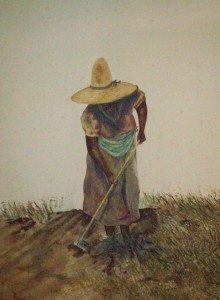
For the simplifying phase of my work, I have several different tools that I use to remove color. If a larger area is involved I generally use (tip) a hard bristled toothbrush, especially to soften hard edges where I’ve used masking. However, toothbrushes tend to flatten and scrubbing and accuracy is affected. If you cut off the tip at an angle and bevel the bristles so they slant from the tip it tends to work much better.
Oddly, when the paint is wet, I use (tip) Q-tips a lot. I find they work better than a sponge in small areas because I have more control over them. I use them extensively when lifting colors to create reflections.
When removing paint without having to wet the paper first, I suggest (tip) a short nib electric eraser. This tool works fabulously and I highly recommend all watercolorists have one nearby.
I mentioned that I preferred Q-tips for certain uses over sponges; however, a watercolor artist can hardly get through a painting without reaching for the old standby, (tip) the sponge. And this includes several different types, sizes and shapes. They are excellent for the use to not only lift paint, but create great textures and values while doing so.
(tip) The Incredible Nib (a point made of the same material as a felt point pin but without ink), with a point on one end and a chiseled edge on the other, can be used for several different purposes other than lifting paint (such as: applying masking, paint, softening edges and other things that might present itself). However, for seriously controlled use of lifting paint, it is ideal.
If you are attempting to create fine lines by removing dried paint, (tip) do so with a razor blade, another must have in your art tool kit.
